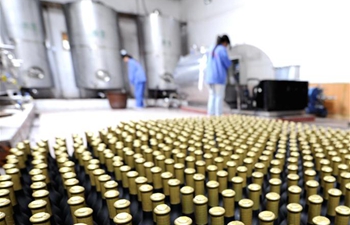CHICAGO, July 13 (Xinhua) -- Researchers at Washington University School of Medicine in St. Louis and the International Centre for Diarrhoeal Disease Research in Dhaka, Bangladesh, have developed a new type of therapeutic food, a mixture of nutrients from chickpea, soy, bananas and peanuts, to repair the gut microbiomes of malnourished children.
The therapeutic food has been proven to be superior to standard therapy in an initial clinical trial conducted in Bangladesh.
The clinical trial included 63 Bangladeshi children, 12 to 18 months of age, diagnosed with moderate acute malnutrition, which means the children were ill but not close to death.
The children were randomly assigned to one of four treatment groups. Children in three of the groups each received one of the three newly designed therapeutic foods, while those in the fourth group received a standard therapeutic food that was not designed based on a consideration of its effects on the gut microbiome.
All foods for the trial were locally produced at the International Centre for Diarrhoeal Disease Research. Children were brought twice daily to a nutritional rehabilitation center, where the therapeutic foods were administered by their mothers under the supervision of healthcare workers.
One of the therapeutic foods stood out from the rest, even in this relatively short one-month trial. Measuring 1,300 blood proteins, including those intimately involved in directing bone growth, development of the brain, immune function, and metabolism in various tissues, this food prototype had produced a pronounced shift toward a healthy state compared with what was observed in the other three groups of children.
At the end of the study, the researchers also found that, unlike in the three other treatment groups, the gut microbial communities residing in the intestines of children receiving this lead therapeutic food had undergone a reconfiguration and more closely resembled microbial communities found in age-matched healthy children living in the same locale.
Existing therapeutic foods were developed to increase the amount of key nutrients children consume. Malnourished children who receive these foods are less likely to die, but other consequences of malnutrition have remained largely unresponsive to treatment, including stunted growth, impaired immunity and reduced cognitive function.
Childhood malnutrition is a massive global health problem, affecting 150 million children under age 5 worldwide, according to the World Health Organization.
The results of the research were published on Friday in the journal Science.

















